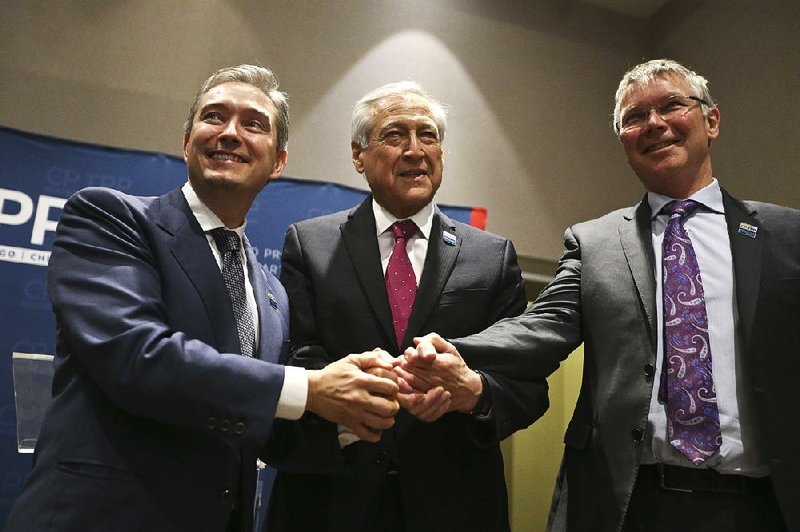SANTIAGO, Chile -- A trade pact originally conceived by the United States to counter China's growing economic might in Asia now has a new target: President Donald Trump's embrace of protectionism.
A group of 11 nations -- including major U.S. allies such as Japan, Canada and Australia -- signed a broad trade deal Thursday that challenges Trump's view of trade as a zero-sum game filled with winners and losers.
Covering 500 million people on either side of the Pacific Ocean, the pact represents a new vision for global trade as the United States threatens to impose steel and aluminum tariffs on even its closest friends and neighbors.
Other members of the pact are Mexico, Vietnam, New Zealand, Chile, Malaysia, Peru, Singapore and Brunei.
Trump withdrew the United States from an earlier version of the agreement, then known as the Trans-Pacific Partnership, a year ago as one of his first acts in office. The resuscitated deal is undeniably weaker without the participation of the world's biggest economy, but it serves as a powerful sign of how countries that have previously counted on U.S. leadership are now forging ahead without it.
"Only free trade will contribute to inclusive growth of the world economy," Taro Kono, Japan's foreign minister, told a group of ministers from Southeast Asian countries in Tokyo on Thursday. "Protectionism isn't a solution."
In its original incarnation, the pact was conceived as a counterweight to China, whose vast economy was drawing other Asian countries closer despite its state-driven model and steep trade barriers. Not only does it lower trade barriers, it also could prod Beijing to make changes to enjoy the same benefits.
When President Barack Obama was advocating the deal, he said that "America should call the shots" instead of China.
Now, the agreement could in some respects act as a defense against the shots the United States is calling.
The United States has "gone from being a leader to actually being the No. 1 antagonist and No. 1 source of fear," said Jeffrey Wilson, head of research at Perth U.S.-Asia Center at the University of Western Australia. "If you're a trade policymaker in Asia, your No. 1 fear is that Trump is going to take a swing at you."
He added that such fears could prompt countries, however reluctantly, to tether themselves more closely to China. "The U.S. is really delivering the region to China at the moment," Wilson said.
The new agreement -- known as the Comprehensive and Progressive Agreement for Trans-Pacific Partnership -- drops tariffs drastically and establishes sweeping new trade rules in markets that represent about a seventh of the world's economy. It opens more markets to free trade in agricultural products and digital services around the region. While U.S. beef faces 38.5 percent tariffs in Japan, for example, beef from Australia, New Zealand and Canada will not.
At a White House ceremony where Trump signed the tariff proclamations, Trump suggested there could be a carve-out for Australia. "We have a very close relationship with Australia, we have a trade surplus with Australia," he said. "We'll be doing something with them. We'll be doing something with some other countries."
Once it goes into effect, the agreement is expected to generate an additional $147 billion in global income, according to an analysis by the Peterson Institute for International Economics. Its backers say it also bolsters protections for intellectual property and includes language that could prod members to improve labor conditions.
"The message is that we believe in the value of an open economy and economic integration of countries in order to generate greater prosperity for our people and our nations," President Michelle Bachelet of Chile said in a recent interview at the presidential palace.
China, which has discussed forming its own regional trade pact, has been more positive about the new deal since the United States pulled out, and Chilean officials said Thursday that China had signaled that it may want to join.
It sent a high-level delegation a year ago to Vina del Mar, Chile, where the pact's members sought to regroup after the United States pulled out. Experts said China could feel the pull if still more countries joined the pact. The pact is also built around fostering trade in sophisticated manufactured goods and high-tech products, and China now produces many of those in abundance.
"It's hard to ignore rules that everyone else is agreeing to, and they will probably look carefully at these rules," said Wendy Cutler, a former U.S. trade negotiator who worked on the Trans-Pacific Partnership and is now managing director of the Washington office of the Asia Society Policy Institute. "Over time, they may want to consider joining the TPP."
Wang Yi, China's foreign minister, said Thursday that the government hoped free-trade agreements in the region would play "a constructive role in their respective fields in resisting trade protectionism and building an open world economy."
In the deal signed Thursday, only 22 of more than 600 original provisions have been suspended, relating to intellectual property protection and a grab bag of other issues, several of which had been pushed by the United States. Kazuyoshi Umemoto, Japan's chief negotiator for the partnership, said that if the United States decided to re-enter the deal, those provisions could be reinstated.
"Trump won't last forever," said Patricio Navia, a political scientist at New York University. "Countries will return to a path toward globalization and this sends a beacon of hope."
Information for this article was contributed by Don Lee of the Los Angeles Times.
Business on 03/09/2018
